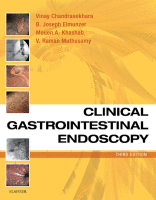Physical Address
304 North Cardinal St.
Dorchester Center, MA 02124
Introduction Sedation is regularly used to facilitate the performance of endoscopic procedures. Sedation practices have noticeably changed over the past decade, with a shift from no or moderate sedation to monitored anesthesia care (MAC) for gastrointestinal (GI) endoscopy. Sedation during…

Introduction The therapeutic basis of all electrosurgery is the use of high frequency, alternating electric current to produce heating in living cells. The heating can be manipulated to achieve a desired tissue effect such as cutting, tissue ablation, desiccation, or…

Endoscopic Biopsy Biopsy Techniques Pinch Biopsy Forceps The most common pinch biopsy forceps used worldwide fits through a 2.8-mm biopsy channel ( Fig. 5.1 ). In general, mucosal samples vary from 4 to 8 mm in size. A smaller-sized forcep that…

Introduction The field of gastrointestinal (GI) endoscopy has expanded dramatically as new procedures, instruments, and accessories have been introduced into the medical community; more than 20 million GI endoscopies are performed annually in the United States. Although GI endoscopes are…

Endoscopes are flexible instruments combining fiber-optics (for illumination) and charge-coupled devices (for imaging) that are used in medicine to visualize the interior of otherwise inaccessible sites, such as the lumen of hollow organs. Endoscopes are used to examine the gastrointestinal…

Introduction The safe and efficient performance of gastrointestinal (GI) endoscopy has the following requirements: A properly trained endoscopist with appropriate privileges to perform specific GI endoscopic procedures Properly trained nursing and ancillary personnel Operational, well-maintained equipment Adequately designed and equipped…

Introduction The role of the physician is to observe, detect anatomic abnormalities or disease, and conceive ways and means by which discovered deficiencies in function can be corrected or ameliorated. To extend the physical examination to areas hidden from external…

15.1 Introduction Endoscopic eradication therapy (EET), either using endoscopic resection (ER) or radiofrequency ablation (RFA), cryoablation, or a combination of resection and ablation, aims not only to completely eliminate Barrett’s esophagus (BE) dysplasia and early neoplasia but also a complete…

14.1 Introduction Barrett’s esophagus (BE) is an acquired condition in which a metaplastic columnar epithelium replaces the stratified squamous epithelium that normally lines the distal esophagus . Metaplasia commonly is a consequence of chronic inflammation, and intestinal metaplasia results from…

13.1 Introduction Earlier chapters in this book describe how ablative therapies have essentially replaced surgery for the management of Barrett’s esophagus (BE) with high-grade dysplasia (HGD). However, resectional therapies, performed either with flexible endoscopy or surgery, are still required for…